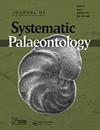The Ordovician diversification of sea urchins: systematics of the Bothriocidaroida (Echinodermata: Echinoidea)
IF 2.2
2区 地球科学
Q3 EVOLUTIONARY BIOLOGY
引用次数: 8
Abstract
The echinoids of the order Bothriocidaroida represent the initial burst of sea urchin diversification. They were the first echinoids to achieve widespread biogeographical dispersal and achieved high levels of species richness compared to other clades of stem group echinoids. Following long-standing controversy regarding their phylogenetic affinities within the phylum Echinodermata, bothriocidaroids are now regarded as echinoids. The species- and genus-level phylogenetic relationships of the bothriocidaroids, are, however, less clearly known. We herein compile a database of bothriocidaroid occurrences, undertake detailed phylogenetic analyses of all named species within the Bothriocidaroida, and provide updated diagnoses for all species. Our phylogenetic analysis includes species belonging to three genera: Bothriocidaris, Unibothriocidaris and Neobothriocidaris. Furthermore, we describe a new species, Neobothriocidaris pentlandensis sp. nov., from the Silurian of Scotland and Sweden, using micro-computed tomography and scanning electron microscopy. This species has implications for understanding the diversity dynamics of bothriocidaroids before and after the Late Ordovician mass extinction and the palaeobiogeographical distribution of bothriocidaroids in the Silurian. Using Bayesian and parsimony-based phylogenetics, we demonstrate that Neobothriocidaris is a distinct clade, and depending upon the analytical technique, Unibothrioidaris and Bothriocidaris are also resolved as monophyletic. Unibothriocidaris appears to have become extinct in the Sandbian, while Neobothriocidaris and Bothriocidaris survived the Late Ordovician extinction events and lasted at least until the Ludlow. Furthermore, we performed statistical time-calibration of our phylogenetic trees and show that bothriocidaroids originated in the Dapingian or Darriwilian, diversifying in the Darriwilian to Sandbian and reaching peak diversity in the Sandbian and Katian. This Sandbian and Katian peak is similar to that observed in other echinoderm clades, as well as other animal groups during the Ordovician radiation, and may be linked to heightened sea level and expansive tropical shelves present in the Upper Ordovician, and to new inhabitable environments linked with Ordovician oxygenation. http://zoobank.org/urn:lsid:zoobank.org:pub:B55D0B22-D4AB-474A-80B9-D19BB43107F0奥陶纪海胆的多样性:刺皮目海胆总科系统分类学
Bothriocidaroida目棘皮类代表了海胆多样化的最初爆发。它们是最早实现广泛生物地理分布的棘皮类,与其他茎类棘皮类分支相比,具有较高的物种丰富度。在棘皮动物门中关于它们的系统发育亲缘关系的长期争论之后,bothriociidaroids现在被认为是棘皮动物。然而,两种和属水平的系统发育关系尚不清楚。在此,我们编制了一个bothriocidaroid发生的数据库,对bothriocidaroid中所有已命名的物种进行了详细的系统发育分析,并提供了所有物种的最新诊断。我们的系统发育分析包括三个属的物种:Bothriocidaris, Unibothriocidaris和Neobothriocidaris。此外,我们还利用微计算机断层扫描和扫描电子显微镜对苏格兰和瑞典志留纪的新物种Neobothriocidaris pentlandensis sp. nov.进行了描述。这一物种对了解晚奥陶世大灭绝前后双生石的多样性动态以及志留纪双生石的古生物地理分布具有重要意义。使用贝叶斯和简约理论为基础的系统发育学,我们证明了Neobothriocidaris是一个独特的分支,并且根据分析技术,Unibothrioidaris和Bothriocidaris也被解决为单系。单角犀似乎在沙边已经灭绝,而新角犀和双角犀在晚奥陶纪灭绝事件中幸存下来,并至少持续到勒德洛。此外,我们对系统发育树进行了统计时间校准,结果表明,双拟虫类起源于大平纪或达里威廉纪,在达里威廉纪向沙边多样化,在沙边和卡田达到多样性高峰。这个沙边和卡天峰与奥陶世辐射期间其他棘皮动物分支和其他动物类群的峰相似,可能与上奥陶世海平面上升和热带大陆架扩张有关,也可能与奥陶世氧化作用导致的新的宜居环境有关。http://zoobank.org/urn:lsid:zoobank.org:pub:B55D0B22-D4AB-474A-80B9-D19BB43107F0
本文章由计算机程序翻译,如有差异,请以英文原文为准。
求助全文
约1分钟内获得全文
求助全文
来源期刊
CiteScore
5.30
自引率
7.70%
发文量
31
审稿时长
>12 weeks
期刊介绍:
The Journal of Systematic Palaeontology publishes papers that provide novel and impactful results in phylogenetics and systematics and that use these results in ways that significantly advance rigorous analyses of palaeogeography, palaeobiology, functional morphology, palaeoecology or biostratigraphy. Papers dealing with theoretical issues or molecular phylogenetics are also considered if they are of relevance to palaeo-systematists. Contributions that include substantial anatomical descriptions, descriptions of new taxa or taxonomic revisions are welcome, but must also include a substantial systematics component, such as a new phylogeny or a revised higher-level classification. Papers dealing primarily with alpha-taxonomic descriptions, the presentation of new faunal/floristic records or minor revisions to species- or genus-level classifications do not fall within the remit of the journal.

 求助内容:
求助内容: 应助结果提醒方式:
应助结果提醒方式:


